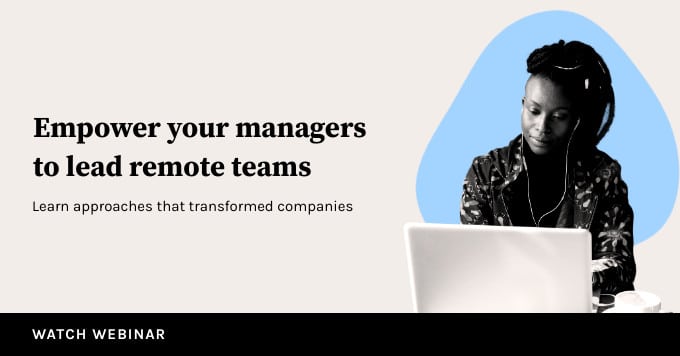Many companies are recruiting remotely to take advantage of an influx of job vacancies. However, as employers lose access to the many data points gathered only with in-person interviews – such as handshakes and how a room’s energy changes when a candidate walks in – they must develop new remote interview process for assessing whether someone is a good fit.
With the Pandemic and the Great Resignation, remote interviewing is unstoppable. Here are a few tips for employers looking to identify top talent in our new virtual workplace.
How to conduct a remote interview
1. Provide candidates with a video interview checklist
Like many companies, candidates are also adjusting to the video job interview experience. Video conferencing is something many candidates have not experienced before. It adds another layer of stress and worries to interviews. The candidate doesn’t just have to worry about preparing for the interview but also learn to use video.
Offering an interview checklist can help relieve a candidate’s anxiety, help them prepare, and improve the candidate’s experience. Let them know that you’re available to assist if they need it. Below are a few suggestions to ease their mind.
- Download and login instructions for the video interview
- Detailed instructions on how to run the software
- Tips for preparing for a video job interview
- Information on the interview process itself, who will attend, timelines, and other essential details
2. Focus on emotional intelligence
Hiring emotionally intelligent people is a challenge. It seems that everyone amps up their positivity during interviews and the first few months on the job. However, once they settle in and go through a honeymoon phase, this positivity can fade.
Emotional intelligence is someone’s ability to read other people’s signals and respond appropriately to them and recognize and understand their own emotions so they can influence the feelings of others. So many interviewers jump way too early into the technical question-and-answer interviewing format without getting to know the candidates individually and on a more personal level.
Allowing candidates to discuss their specific interest in the role or organization, their career ambitions, or their status in the job-search process, you’ll likely find that trust and goodwill can develop. It is essential to find candidates who possess the personality traits your company values. When you can’t feel the energy of the room in a virtual interview, it is even more challenging to hire emotionally intelligent employees, but here are some great questions to ask:
- What would your top three values be if you started a company tomorrow?
- Tell me about a workplace conflict you were involved in, either with your peers or someone else in the company. How did you manage that conflict, and were you able to resolve it?
- What skills have you developed to be able to manage conflicting priorities and work with multiple supervisors simultaneously?
- Tell me about a time when you disagreed with feedback on your performance. How did you handle the situation?
- What inspires you?
3. Streamline your remote interview questions
Try to keep your video conferencing time as short as possible. Using this method will allow you to maximize the amount of time you have available. Focus on the most important questions to ask and take creative approaches to cover the rest. No matter how thoroughly you test your technology beforehand, you can still encounter problems. To avoid running out of time or running into technical issues, use your time online as efficiently as possible. Script the essential interview questions and plan the structure of your interview.
4. Notice reactions and distractions
Our office work was sometimes interrupted by possible personal phone calls or dealing with a family matter away from home. We all must deal with these situations from time to time. Today, virtually, we can find a wide variety of distractions that can pop up. A doorbell rings, the dog barks, a child cries, or a phone call. People’s lives are now blended. They work at home and live at work, meaning distractions are easy and sometimes unpredictable and unavoidable.
If distraction happens to your candidate during the interview, consider it an opportunity to glimpse another side of the candidate. Have they lost focus or become flustered during the interview? Did they handle the disruption gracefully, as you would expect from a client or colleague? Consider asking how they would respond in the case that a “zoom nightmare” were to happen.
5. Watch for warning signs
The red flags you look for during an in-person interview are essentially the same as those you look for during a virtual interview. There are some further warning signs to be aware of during interviews conducted remotely.
- The candidate exhibits sloppy behavior or grooming. A virtual interview doesn’t grant candidates the right to show up in their PJs or sweatpants and avoid speaking professionally. Dressing or acting too casually during an interview may indicate that the person is not serious about the job or company.
- The candidate seems uncomfortable with communicating. Those who are used to in-person interviews may feel some discomfort in front of the camera — but good leadership communication skills are crucial. Consider whether candidates are having difficulty articulating themselves or answering questions.
- The candidate hasn’t minimized noises and distractions during the interview. Again, this can signify that candidates aren’t genuinely interested in the job or your company. When hired, will they reduce distractions if they are working at home if they haven’t taken the time to prepare for the interview?
In the post-pandemic world, traditional hiring practices will be combined with newly adopted virtual processes, say experts. Getting a job and being interviewed has changed drastically since 2020 and remote interviewing has become one of the core remote leadership skills . Just like an in-person interview, we certainly encourage taking the time to prepare. A common mistake is an inadequate preparation. The best approach is to prepare as much for a virtual interview as you would for a face-to-face meeting.


